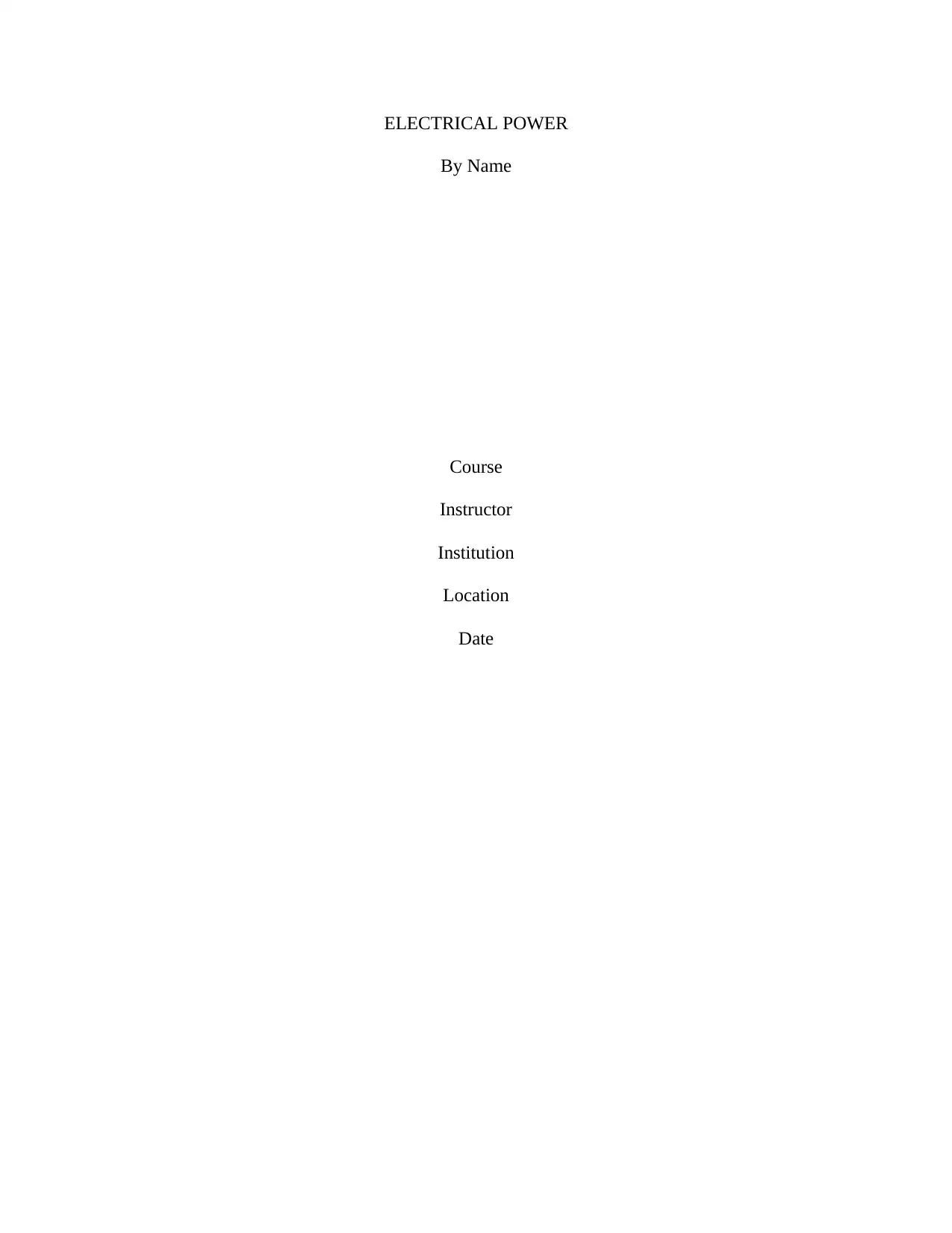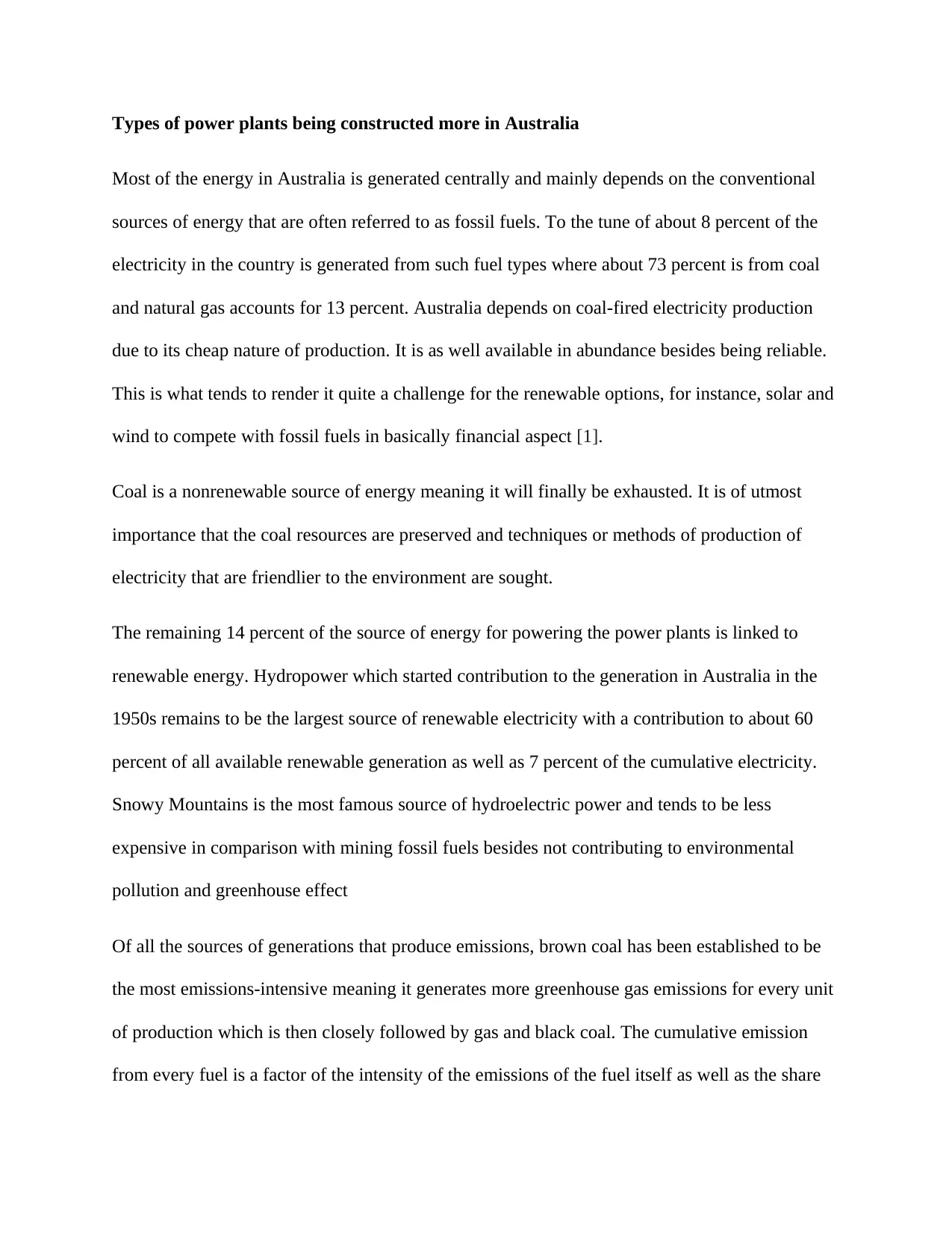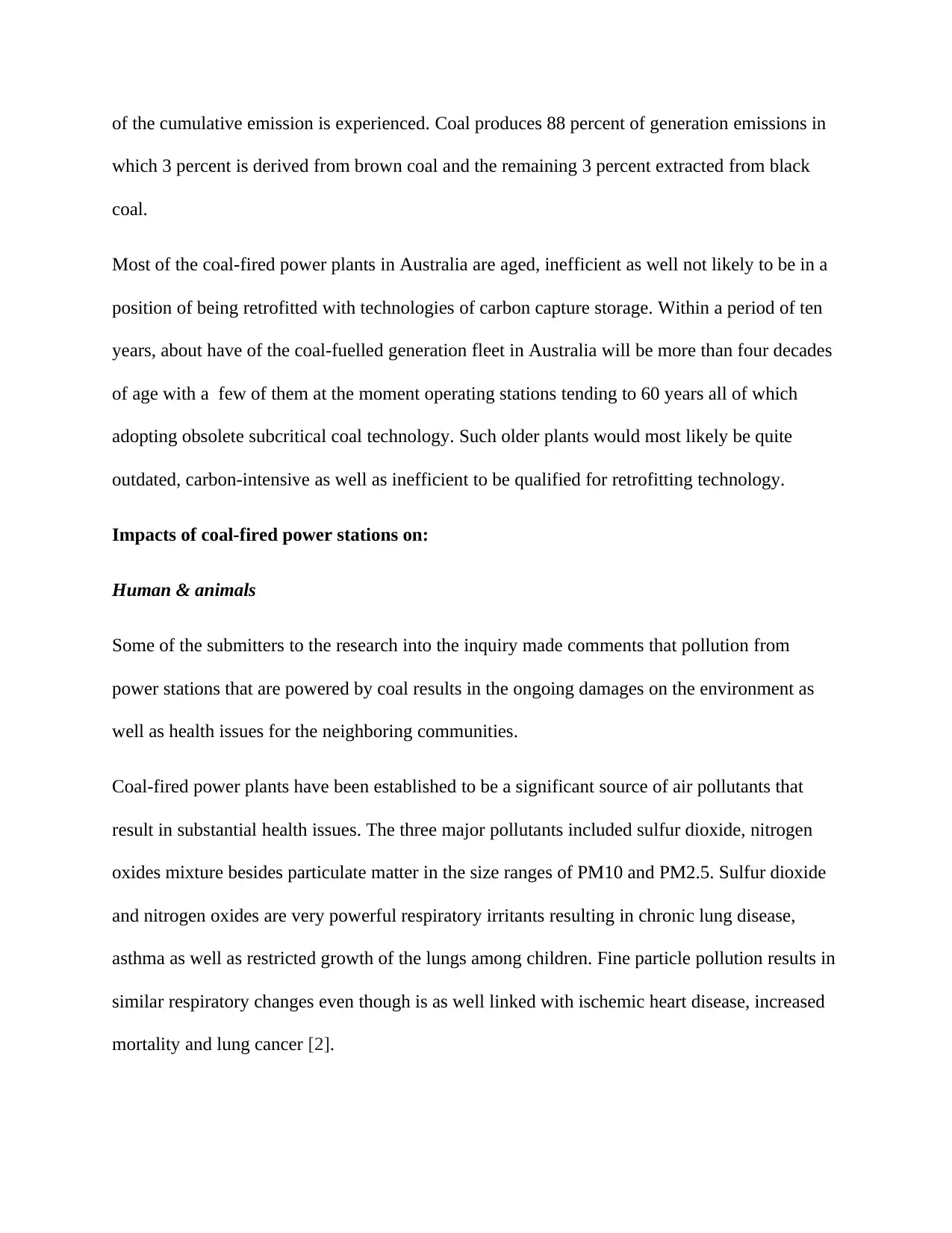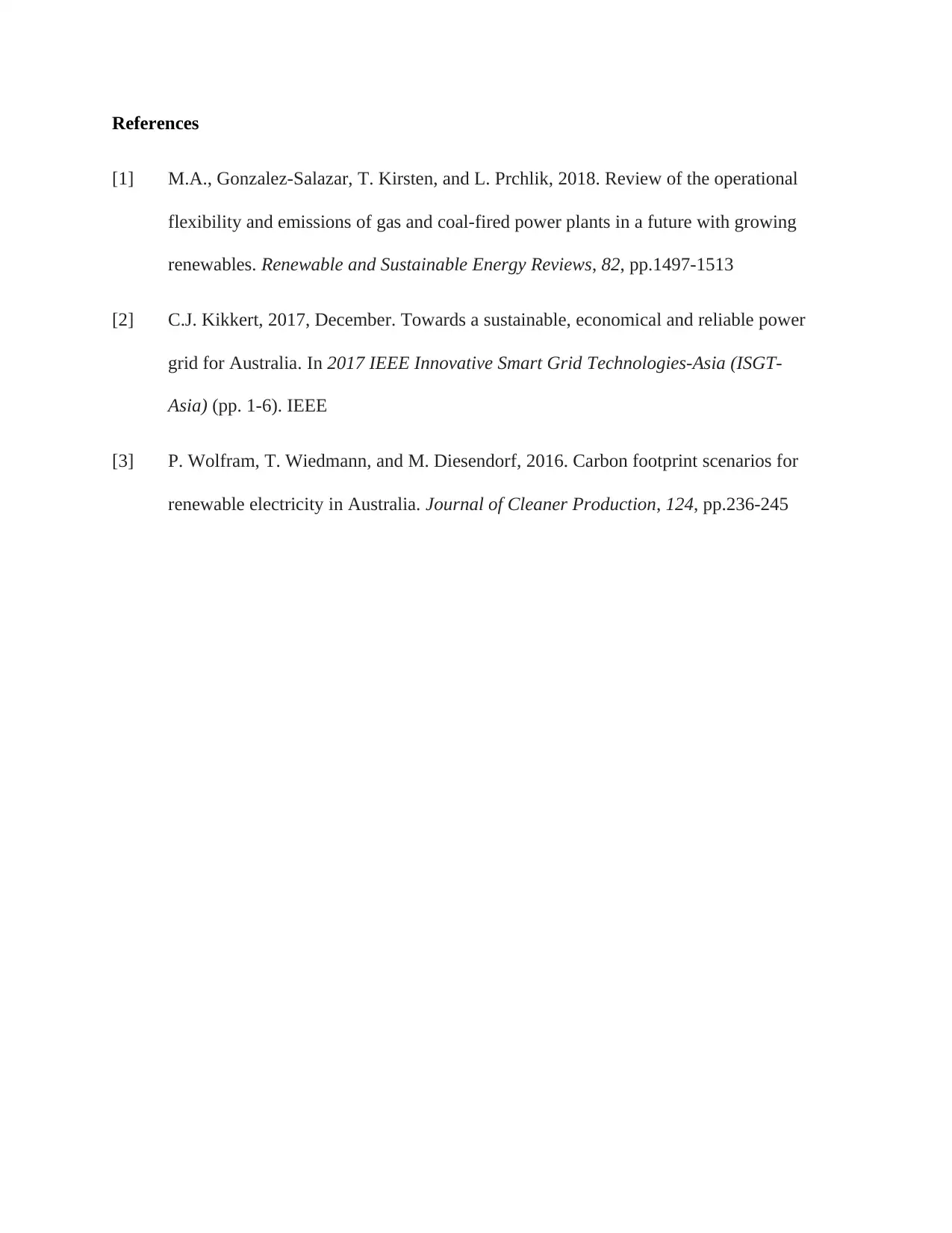Electrical Power Generation in Australia: A Comprehensive Report
VerifiedAdded on 2022/12/21
|6
|1139
|31
Report
AI Summary
This report provides a comprehensive overview of electrical power generation in Australia, emphasizing the dominance of fossil fuels, particularly coal, and its associated environmental impacts. It highlights that a significant portion of Australia's electricity is generated from coal, making it a cheap but non-renewable source. The report discusses the environmental and health consequences of coal-fired power plants, including air pollution and greenhouse gas emissions. It also examines the role of renewable energy sources, such as hydropower, and the government's efforts to meet the Paris Agreement targets by increasing renewable energy systems and reducing reliance on coal. The report also discusses the need for significant adjustments in the electricity sector to meet emission reduction targets, including the potential closure of coal-fired power stations and the scaling up of renewable energy sources.

ELECTRICAL POWER
By Name
Course
Instructor
Institution
Location
Date
By Name
Course
Instructor
Institution
Location
Date
Paraphrase This Document
Need a fresh take? Get an instant paraphrase of this document with our AI Paraphraser

Types of power plants being constructed more in Australia
Most of the energy in Australia is generated centrally and mainly depends on the conventional
sources of energy that are often referred to as fossil fuels. To the tune of about 8 percent of the
electricity in the country is generated from such fuel types where about 73 percent is from coal
and natural gas accounts for 13 percent. Australia depends on coal-fired electricity production
due to its cheap nature of production. It is as well available in abundance besides being reliable.
This is what tends to render it quite a challenge for the renewable options, for instance, solar and
wind to compete with fossil fuels in basically financial aspect [1].
Coal is a nonrenewable source of energy meaning it will finally be exhausted. It is of utmost
importance that the coal resources are preserved and techniques or methods of production of
electricity that are friendlier to the environment are sought.
The remaining 14 percent of the source of energy for powering the power plants is linked to
renewable energy. Hydropower which started contribution to the generation in Australia in the
1950s remains to be the largest source of renewable electricity with a contribution to about 60
percent of all available renewable generation as well as 7 percent of the cumulative electricity.
Snowy Mountains is the most famous source of hydroelectric power and tends to be less
expensive in comparison with mining fossil fuels besides not contributing to environmental
pollution and greenhouse effect
Of all the sources of generations that produce emissions, brown coal has been established to be
the most emissions-intensive meaning it generates more greenhouse gas emissions for every unit
of production which is then closely followed by gas and black coal. The cumulative emission
from every fuel is a factor of the intensity of the emissions of the fuel itself as well as the share
Most of the energy in Australia is generated centrally and mainly depends on the conventional
sources of energy that are often referred to as fossil fuels. To the tune of about 8 percent of the
electricity in the country is generated from such fuel types where about 73 percent is from coal
and natural gas accounts for 13 percent. Australia depends on coal-fired electricity production
due to its cheap nature of production. It is as well available in abundance besides being reliable.
This is what tends to render it quite a challenge for the renewable options, for instance, solar and
wind to compete with fossil fuels in basically financial aspect [1].
Coal is a nonrenewable source of energy meaning it will finally be exhausted. It is of utmost
importance that the coal resources are preserved and techniques or methods of production of
electricity that are friendlier to the environment are sought.
The remaining 14 percent of the source of energy for powering the power plants is linked to
renewable energy. Hydropower which started contribution to the generation in Australia in the
1950s remains to be the largest source of renewable electricity with a contribution to about 60
percent of all available renewable generation as well as 7 percent of the cumulative electricity.
Snowy Mountains is the most famous source of hydroelectric power and tends to be less
expensive in comparison with mining fossil fuels besides not contributing to environmental
pollution and greenhouse effect
Of all the sources of generations that produce emissions, brown coal has been established to be
the most emissions-intensive meaning it generates more greenhouse gas emissions for every unit
of production which is then closely followed by gas and black coal. The cumulative emission
from every fuel is a factor of the intensity of the emissions of the fuel itself as well as the share

of the cumulative emission is experienced. Coal produces 88 percent of generation emissions in
which 3 percent is derived from brown coal and the remaining 3 percent extracted from black
coal.
Most of the coal-fired power plants in Australia are aged, inefficient as well not likely to be in a
position of being retrofitted with technologies of carbon capture storage. Within a period of ten
years, about have of the coal-fuelled generation fleet in Australia will be more than four decades
of age with a few of them at the moment operating stations tending to 60 years all of which
adopting obsolete subcritical coal technology. Such older plants would most likely be quite
outdated, carbon-intensive as well as inefficient to be qualified for retrofitting technology.
Impacts of coal-fired power stations on:
Human & animals
Some of the submitters to the research into the inquiry made comments that pollution from
power stations that are powered by coal results in the ongoing damages on the environment as
well as health issues for the neighboring communities.
Coal-fired power plants have been established to be a significant source of air pollutants that
result in substantial health issues. The three major pollutants included sulfur dioxide, nitrogen
oxides mixture besides particulate matter in the size ranges of PM10 and PM2.5. Sulfur dioxide
and nitrogen oxides are very powerful respiratory irritants resulting in chronic lung disease,
asthma as well as restricted growth of the lungs among children. Fine particle pollution results in
similar respiratory changes even though is as well linked with ischemic heart disease, increased
mortality and lung cancer [2].
which 3 percent is derived from brown coal and the remaining 3 percent extracted from black
coal.
Most of the coal-fired power plants in Australia are aged, inefficient as well not likely to be in a
position of being retrofitted with technologies of carbon capture storage. Within a period of ten
years, about have of the coal-fuelled generation fleet in Australia will be more than four decades
of age with a few of them at the moment operating stations tending to 60 years all of which
adopting obsolete subcritical coal technology. Such older plants would most likely be quite
outdated, carbon-intensive as well as inefficient to be qualified for retrofitting technology.
Impacts of coal-fired power stations on:
Human & animals
Some of the submitters to the research into the inquiry made comments that pollution from
power stations that are powered by coal results in the ongoing damages on the environment as
well as health issues for the neighboring communities.
Coal-fired power plants have been established to be a significant source of air pollutants that
result in substantial health issues. The three major pollutants included sulfur dioxide, nitrogen
oxides mixture besides particulate matter in the size ranges of PM10 and PM2.5. Sulfur dioxide
and nitrogen oxides are very powerful respiratory irritants resulting in chronic lung disease,
asthma as well as restricted growth of the lungs among children. Fine particle pollution results in
similar respiratory changes even though is as well linked with ischemic heart disease, increased
mortality and lung cancer [2].
⊘ This is a preview!⊘
Do you want full access?
Subscribe today to unlock all pages.

Trusted by 1+ million students worldwide

Environment
The pollutants can travel quite long distances thus even though power stations are situated off the
cities, they contribute to major pollution of the city alongside having greater impacts on the local
towns. This has been demonstrated in the case in which half of the particles of sulfate at
Richmond located in western Sydney might be traced back to one of the coal-powered stations
even though such is situated 70, 90 and 140 km away. In as much as the effects on climate by
coal-fired plants are distinct and delayed, the effects of air pollution tend to be regional and
immediate hence need to be considered during the planning of transition of power production off
fossil fuels.
Steps that are taken by the Australian government
In a bid to meet the targets of the Paris agreement as well as to effectively aid in combating the
effects of coal-fired production of electricity, there has to be in place a correlating increase in the
systems of renewable energy. At the moment, the coal sector tends to be the biggest contributor
to the emissions in Australia in which to the tune of 188 million tons was generated in 2014. Be
it a pro-rata adjustment to reduction which are needed and committed to now by the country by
2030 or likely a further extension of the same based on the ineffectively of the current to attain
the glide path of two degree Celsius by any measure, abetment in the sector of electricity many
be needed by the close of 2030 of between about 40 million and 100 million tons every year
acknowledging that at the moment the prevailing value is about 188 million tons every year. So
such tend to be quite large adjustments [3].
The current targets of renewable energy which is the large target will just lower abatement
within the stipulated time frame by about 30 million tons every year in case it is fully developed.
The pollutants can travel quite long distances thus even though power stations are situated off the
cities, they contribute to major pollution of the city alongside having greater impacts on the local
towns. This has been demonstrated in the case in which half of the particles of sulfate at
Richmond located in western Sydney might be traced back to one of the coal-powered stations
even though such is situated 70, 90 and 140 km away. In as much as the effects on climate by
coal-fired plants are distinct and delayed, the effects of air pollution tend to be regional and
immediate hence need to be considered during the planning of transition of power production off
fossil fuels.
Steps that are taken by the Australian government
In a bid to meet the targets of the Paris agreement as well as to effectively aid in combating the
effects of coal-fired production of electricity, there has to be in place a correlating increase in the
systems of renewable energy. At the moment, the coal sector tends to be the biggest contributor
to the emissions in Australia in which to the tune of 188 million tons was generated in 2014. Be
it a pro-rata adjustment to reduction which are needed and committed to now by the country by
2030 or likely a further extension of the same based on the ineffectively of the current to attain
the glide path of two degree Celsius by any measure, abetment in the sector of electricity many
be needed by the close of 2030 of between about 40 million and 100 million tons every year
acknowledging that at the moment the prevailing value is about 188 million tons every year. So
such tend to be quite large adjustments [3].
The current targets of renewable energy which is the large target will just lower abatement
within the stipulated time frame by about 30 million tons every year in case it is fully developed.
Paraphrase This Document
Need a fresh take? Get an instant paraphrase of this document with our AI Paraphraser

For this reason, there is needed to scale up renewable energy to large scales. Most of the studies
indicated that for Australia to attain the reduction in emissions target that has been committed by
the government, a significant portion of the coal-fired stations in Australia will need to be shut
down by 2030.
indicated that for Australia to attain the reduction in emissions target that has been committed by
the government, a significant portion of the coal-fired stations in Australia will need to be shut
down by 2030.

References
[1] M.A., Gonzalez-Salazar, T. Kirsten, and L. Prchlik, 2018. Review of the operational
flexibility and emissions of gas and coal-fired power plants in a future with growing
renewables. Renewable and Sustainable Energy Reviews, 82, pp.1497-1513
[2] C.J. Kikkert, 2017, December. Towards a sustainable, economical and reliable power
grid for Australia. In 2017 IEEE Innovative Smart Grid Technologies-Asia (ISGT-
Asia) (pp. 1-6). IEEE
[3] P. Wolfram, T. Wiedmann, and M. Diesendorf, 2016. Carbon footprint scenarios for
renewable electricity in Australia. Journal of Cleaner Production, 124, pp.236-245
[1] M.A., Gonzalez-Salazar, T. Kirsten, and L. Prchlik, 2018. Review of the operational
flexibility and emissions of gas and coal-fired power plants in a future with growing
renewables. Renewable and Sustainable Energy Reviews, 82, pp.1497-1513
[2] C.J. Kikkert, 2017, December. Towards a sustainable, economical and reliable power
grid for Australia. In 2017 IEEE Innovative Smart Grid Technologies-Asia (ISGT-
Asia) (pp. 1-6). IEEE
[3] P. Wolfram, T. Wiedmann, and M. Diesendorf, 2016. Carbon footprint scenarios for
renewable electricity in Australia. Journal of Cleaner Production, 124, pp.236-245
⊘ This is a preview!⊘
Do you want full access?
Subscribe today to unlock all pages.

Trusted by 1+ million students worldwide
1 out of 6
Related Documents
Your All-in-One AI-Powered Toolkit for Academic Success.
+13062052269
info@desklib.com
Available 24*7 on WhatsApp / Email
![[object Object]](/_next/static/media/star-bottom.7253800d.svg)
Unlock your academic potential
Copyright © 2020–2025 A2Z Services. All Rights Reserved. Developed and managed by ZUCOL.





